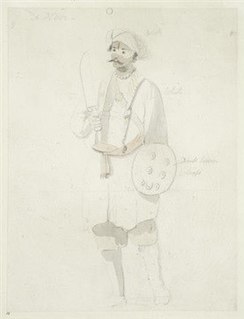
The Nair, also known as Nayar, are a group of Indian Hindu castes, described by anthropologist Kathleen Gough as "not a unitary group but a named category of castes". The Nair include several castes and many subdivisions, not all of whom historically bore the name 'Nair'. These people lived, and continue to live, in the area which is now the Indian state of Kerala. Their internal caste behaviours and systems are markedly different between the people in the northern and southern sections of the area, although there is not very much reliable information on those inhabiting the north.

Kolam, also known as Muggu is a form of drawing that is drawn by using rice flour, chalk, chalk powder or rock powder, often using naturally or synthetically colored powders. It originated in Tamil Nadu and has since spread to the other Indian states of Karnataka, Telangana, Andhra Pradesh, and Kerala, and some parts of Goa and Maharashtra, as well as Indonesia, Malaysia, Thailand and a few other Asian countries. A Kolam is a geometrical line drawing composed of curved loops, drawn around a grid pattern of dots. In South India and Sri Lanka, it is widely practised by female Hindu family members in front of their houses. Kolams are regionally known by different names in India, Raangolee in Maharashtra, Aripan in Mithila, Hase and Rangoli in Kannada in Karnataka. More complex Kolams are drawn and colors are often added during holiday occasions and special events.
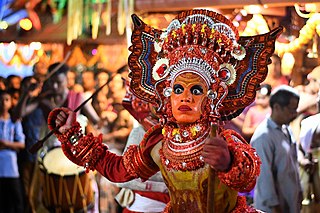
Theyyam is a popular ritual form of dance worship in Kerala and Karnataka, India. Theyyam consisted of several thousand-year-old traditions, rituals and customs. The performers of Theyyam belong to the lower caste community in ancient caste structure formed by Namboothiri brahmins in Kerala, and have an important position in Theyyam. The people of these districts consider Theyyam itself as a channel to a God and they thus seek blessings from Theyyam. It is performed by mainly by males, except the Devakoothu theyyam. The Devakoothu is the only Theyyam ritual performed by women.It is performed only on the Thekkumbad Kulom temple.
Pushpaka is a caste of Hindu Brahmins of Kerala. In Malayalam language, this caste is also referred to as Pushpakan, Pushpakar, Pushpaka Unni or Pushpakan Unni. They are a part of the Ambalavasi community in Kerala. They carry out the various activities of the temple like teaching of sacred texts, garland making, lamp works etc., and sometimes they perform actual priestly activities also. The male members of this caste generally use the surname Unni with their name. They also use the surnames Nambi and Sarma.
The Pulayar is a Dalit (untouchable) caste in Hinduism, forming one of the main social groups in modern-day Kerala and Karnataka as well as in historical Tamil Nadu or Tamilakam.
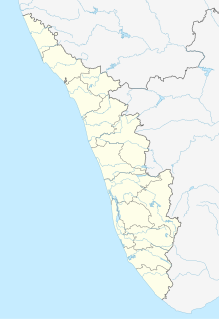
Kunnathur Padi is the historic center for the folk Hindu deity Sree Muthappan. The center stands in the Kannur District of the Kerala state of South India, 3,000 feet above sea level, on top of Udumbumala in the Sahyadri mountains.
The Billava, Billoru, Biruveru people are an ethnic group of India. They are found traditionally in coastal Karnataka and engaged in toddy tapping, cultivation and other activities. They have used both missionary education and Sri Narayana Guru's reform movement to upgrade themselves.
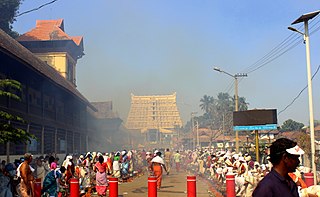
Attukal is a Hindu pilgrimage centre in Thiruvananthapuram, Kerala, India. It is situated about two kilometres to the south east from Sree Padmanabhaswamy Temple in Thiruvananthapuram City.
The caste system in Kerala differed from that found in the rest of India. While the Indian caste system generally modeled the four-fold division of society into Brahmins, Kshatriyas, Vaishyas and Shudras, in Kerala the Nambudiri Brahmins formed the priestly class and only rarely recognized anyone else as being other than Shudra or untouchables, the latter being outside the caste system entirely. Thus, the Kerala caste system was ritualized but it was not the varna model found elsewhere. In Southern India, only in Kerala did there appear warrior lineages approximate to the Kshatriya model. These warriors never lost their identity as Sudras. Nair Kshatriya hood is based on special ecological conditions and it is a case of elevated sudra to Kshatriya status.
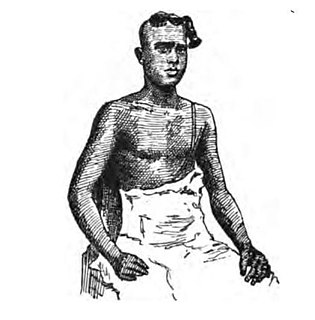
The Nambudiri(Malayalam pronunciation: [n̪ampuːtɪɾɪ]), also transliterated Nambūdiri, Namboodiri, Namboothiri, and Nampūtiri, NampiThiru, are a Malayali Brahmin caste, native to what is now the state of Kerala, India.

Pulluvan is a scheduled caste group in Kerala. They belong to the Hindu religion. The term pullu means a bird of omen. There are many sub-divisions within the Pulluva community, the majority known as Nagampatikal. There are also pulluvars who are not Naagampatikal, known as Pretampatikal.

The Ezhavas are a community with origins in the region of India presently known as Kerala, where in the 2010s they constituted about 23% of the population and were reported to be the largest Hindu community. They are also known as Ilhava, Irava, Izhava and Erava in the south of the region; as Chovas, Chokons and Chogons in Central Travancore; and as Thiyyar, Tiyyas and Theeyas in the Malabar region. Some are also known as Thandan, which has caused administrative difficulties due to the presence of a distinct caste of Thandan in the same region. The Malabar Thiyyar group have claimed a higher ranking in the Hindu caste system than do the others, although from the perspective of the colonial and subsequent administrations they were treated as being of similar rank.
Ambalavasi, lit. 'temple-dwelling', is a generic name for a group of castes among Hindus in Kerala, India, who render temple services. Some Ambalavasi castes are patrilineal, while the others are matrilineal. Those that practise matrilineality share many cultural similarities with the Nair caste. Their ritual rank in Hinduism lies below the Brahmin castes and above the Nairs.

Vallicode is a village in Pathanamthitta district in Kerala, India. It is situated at about 7 km from the district headquarters of Pathanamthitta at south-east direction.

Kuthiyottam, sometimes spelled Kutiyottam, is a ritual youth dance, and in some cases of mock blood sacrifice, found at annual Pongala festival celebrations at some Hindu temples in Kerala dedicated to Bhadrakali or Durga – a warrior goddess. This ritual features volunteer teenage or younger boys who live under austere conditions over the festival period in the Malayalam calendar month of Kumbham. They wear ascetic clothes, abstain from meat and eat simple food, participate in daily prayers in the temple. They also dress up in ceremonial clothes and perform as singers and dancers under the guidance of an asan (conductor). These dances are synchronized with the legends of the goddess. These dances are highly energetic, paced to the beat of drums, with singers and feature traditional costumes.

Orkkatteri is a small town in Kozhikode district in the North Malabar region of state of Kerala, India. This is the center town for Eramala grama panchayath.
Nambidi is a caste of Kerala, India. The form a part of the Brahmin community. They are considered to be KeralaBrahmins and to have originated when a section of the Nambudiris was degraded or a section of the Nairs was upgraded in the caste system. They also have the same rights and rituals of nambudiri's. The nambidi ladies are usually called Mandals / Atholammas used to wear the cheruthalis and are similar to Antharjanams. The nambidi's also had great economic and Societic importance and have the same grade of Nambudiris in the Society. They have no right to do Poojas in temples. Nambidis are divided into two: the ones who wear the sacred thread and perform the Upanayanam and the ones who do not. The former are Nambudiris who were degraded to the Brahmins status since their ancestors had committed a heinous act by murdering a ruler of Kerala. On their return the other Nambudiris welcomed them but they refused to seat themselves with the other Brahmins owing to the sin they committed and instead sat on the steps of the hall. They came to be known as Nom Padimels or those on the steps and this term was later corrupted into Nambidi. The latter are Nairs who were assigned the Nambidi title. Namboodiris will Join with nambidi's in all their functions and rituals.

Padayani, also known Padeni, is a traditional folk dance and a ritual art from the central portion of the Indian state of Kerala. A ceremonial dance involving masks, it is an ancient ritual performed in Bhagavati temples. The dance is performed in honor of Bhadrakaali. Meaning, a 'row of warriors', Padayani is an art form that blends music, dance, theatre, satire, facial masks, and paintings. It is part of worship of Bhadrakali and is staged in temples dedicated to the goddess from mid-December to mid-May. Padayani is unique to central Travancore, comprising the Pathanamthitta and kottayam districts of Kerala. Padayani is regarded as a remnant of the Dravidian forms of worship that existed before the advent of Brahmanism.
Othera Puthukulangara Devi Temple is an ancient Hindu temple situated in the Othera village of Thiruvalla Taluk in Pathanamthitta district, Kerala, India, that is dedicated to the goddess, Durga Devi. The temple is owned by A Trust and an elected committee administrates the temple. The nearest town is Chengannur and Chengannur Railway Station is 5 km from this temple.











